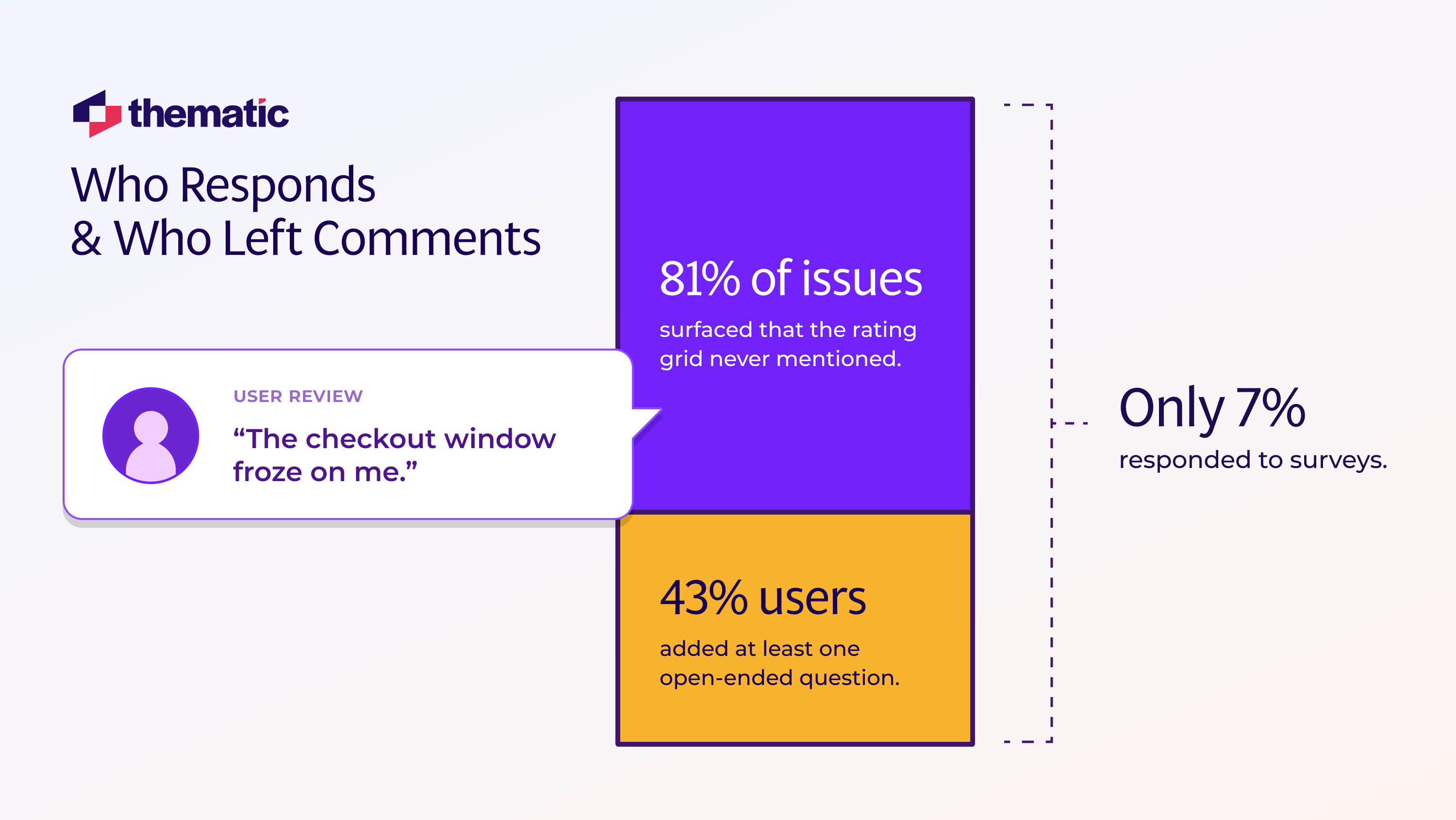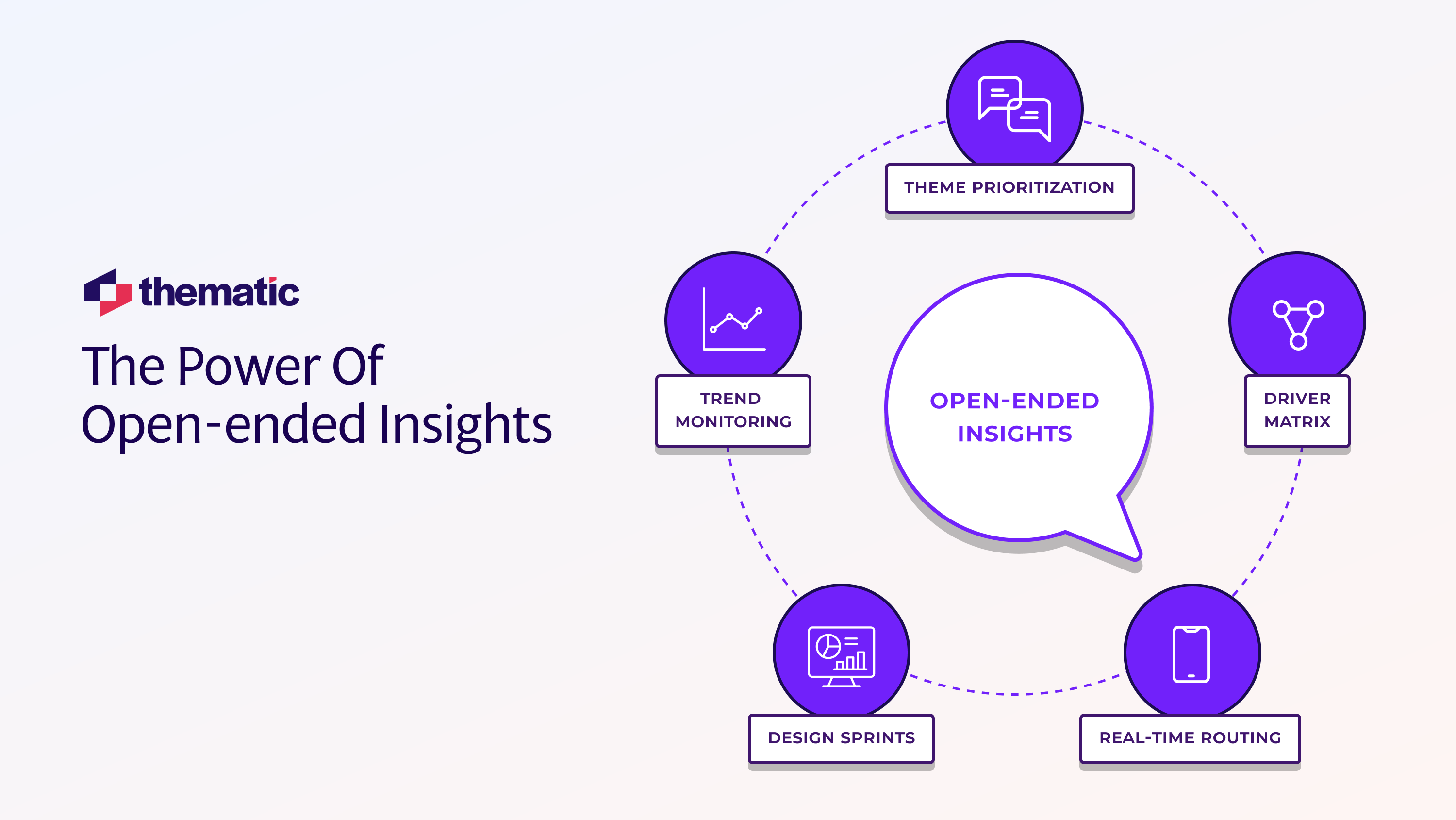
Capture context and sentiment with open-ended survey prompts to drive actionable VoC insights and boost response rates.

This article is Part 2 of our three-part series on Open-Ended Questions. Part 1 introduces how to "Choose Open-Ended Comments and Conversations Over Rating Scales" and Part 3 covers "How to Use Open‑Ended Feedback Across Your Organization".
A customer rating of 3 out of 5 doesn’t tell you much. Was the customer satisfied, indifferent, or just having a bad day? . In the first article of our 3-part series on Open-Ended Questions, Choose Open-Ended Comments and Conversations Over Rating Scales, we discussed why numbers alone aren’t enough. One powerful way to get more meaningful insights is to ask open-ended questions in your surveys.
Unlike a checkbox or star rating, an open-ended question invites people to share feedback in their own words. It’s a simple addition that can transform your survey program. Allowing customers to explain their scores helps you tap into the context and sentiments behind the numbers.
In this article, we’ll explore why open-ended questions are so valuable and how to use them effectively to elevate your Voice of Customer program.
Open-ended questions let respondents tell the story behind their answers. Instead of choosing from predefined options, people can write what they really think and feel. This gives you detailed context, sentiment, and motivation that a numeric score alone can’t capture.
Here’s why it matters:

What open-ended questions reveal:
How open-enders complement closed-ended questions:
What research shows:
In short, open-ended questions elevate your feedback program. You hear the voice of the customer, not just see a score.
Authored by Alyona Medelyan (PhD in Natural Language Processing & Machine Learning), this is a complete guide on the analysis of qualitative data. Learn the key approaches to analysis, how to set up a coding frame, how to code data accurately, and much more.
Download your free copy today!
Open‑enders work best when short, focused, and shown at the right moment. Use the checklist below to guide your design. Pick the tactics that fit your program, and then test and refine.
Swap the single “big‑bang” annual questionnaire for a bank of open‑ended prompts you can draw from all year. Match each prompt to a product journey stage, an employee touchpoint, or a research theme. A living library keeps surveys fresh and lets you surface richer product ideas.
Identify the two or three interactions that shape loyalty most (checkout, onboarding, renewal). Right after each moment, ask a simple why/why‑not question. For example: “What almost stopped you from buying today?” Timely context sharpens the answers.
Use one additional open‑ender directly after a key score like CSAT or NPS. The number says how someone feels, while the narrative explains why. Avoid tacking a free‑text field onto every scale. Selective pairing keeps fatigue low.
Branching rules make long surveys feel short. Show an open‑ended prompt only when it adds value, after a low score, a skipped feature, or a certain product choice. Respondents see relevant questions, and you collect cleaner data.
Write in plain, conversational language. Ask “What could we improve?” instead of “Why was the service bad?” Neutral wording invites balanced stories and reduces bias, which improves sentiment and thematic analysis later.
Craft questions so the reply can fuel both a synthetic score (for dashboards) and the narrative that explains it. Here’s how you might do that for an employee survey:
Metric: Manager support
Prompt: “In your daily work, what aspects of your manager’s support help you most and what could improve?”
This single item feeds trust and communication metrics while uncovering concrete improvement ideas.
You’ve collected rich stories. Now turn them into action. Below are five practical ways CX and research teams apply open‑ended insights weekly. (For the nuts‑and‑bolts of applying AI text analytics, check out our companion guide).
These five moves shift the conversation from data collection to value creation. Your surveys become a live pulse on customer needs, guiding everyday decisions across the organisation.

Embracing open‑ended questions is only the first step. Your next goal is to build internal skill in reading and using the themes that surface. Start small: pull the top five themes from recent survey comments. Show teams how each theme links to a KPI (churn, repeat purchase, or NPS). When people see that "delivery delay" predicts a three‑point drop in satisfaction, they grasp how text can drive decisions.
Next, teach basic driver analysis. Pair each theme’s frequency or sentiment with outcome metrics. A quick regression or correlation table reveals which themes push loyalty up or down. Highlight one insight per meeting and track the impact of any fix so leaders feel the payoff.
As confidence grows, enrich the VoC program. Feed in chat logs, support tickets, or product reviews, and map them onto the survey themes. Seeing the same pain point in three channels proves it’s real.
Finally, share the wins. When decision makers trust unstructured data - invite marketing, operations, and finance to add their datasets. Shared themes unify priorities, and a broader analytics pool yields deeper insight. Step by step, open‑ended expertise becomes a cross‑company advantage.

AI-powered software to transform qualitative data into powerful insights that drive decision making.
Open‑ended responses are a powerful asset when you have large volumes of them.. They reveal the reasons behind every score, not just the score itself, and that deeper view guides smarter decisions.
Insights only matter if they lead to useful action. The next step is turning what you’ve discovered into change and sharing your results. Fix what annoys clients, amplify what delights them, then measure the change. Why not prioritize your top five themes and track their sentiment quarter‑by‑quarter? When "delivery delay" drops from headline issue to footnote, you can show stakeholders the payoff.
Want to dive deeper into designing great open‑ended questions? Check out our Open Enders guide to learn more.
Read more about Open Enders with Part 1 of our series exploring how to "Choose Open-Ended Comments and Conversations Over Rating Scales" and Part 3 covering "How to Use Open‑Ended Feedback Across Your Organization".
Join the newsletter to receive the latest updates in your inbox.